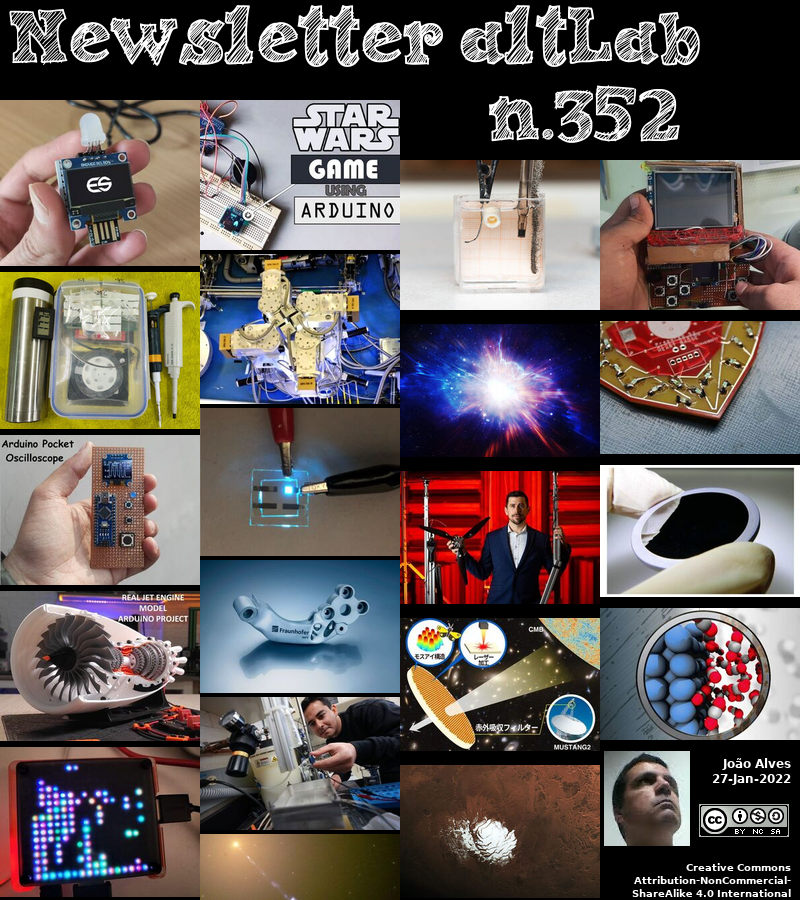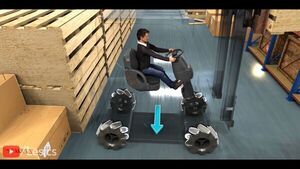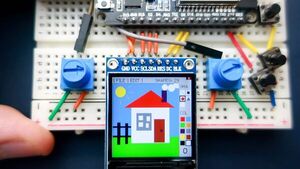2022-01-27 - Nº 352
Editorial
Esta é a Newsletter Nº 352 que se apresenta com o mesmo formato que as anteriores. Se gostar da Newsletter partilhe-a!
Todas as Newsletters encontram-se indexadas no link.
Esta Newsletter tem os seguintes tópicos:
Faz hoje anos que nascia, em 1792, o relojoeiro e inventor norte-americano Phineas Davis. Ele virou das suas capacidades de autodidata de fazer jóias e relógios para inventar a primeira locomotiva a carvão bem sucedida construída nos E.U.A. Anteriormente, os caminhos-de-ferro utilizavam locomotivas importadas. A 4 de Janeiro de 1831, a Baltimore e a Ohio Railroad Company anunciaram um prémio de 4.000 dólares para o melhor motor em ensaios realizados em Junho de 1831. Davis criou a sua locomotiva de York e ganhou o concurso.
Faz também hoje anos que nascia, em 1832, o matemático, fotógrafo, e romancista inglês Lewis Carroll. Com o verdadeiro nome de Charles Lutwidge Dodgson, ele é conhecido pelas Aventuras de Alice no País das Maravilhas (1865) e a sua sequela. Depois de se formar no Christ Church College, Oxford em 1854, Dodgson permaneceu lá, dando palestras sobre matemática e tratados de escrita até 1881. Como matemático, Dodgson era conservador. Foi autor de um bom número de livros de matemática, por exemplo, A Syllabus of Plane Algebraical Geometry (1860). Os seus livros de matemática não provaram ter uma importância duradoura, excepto Euclides e os seus Rivais Modernos (1879), que são de interesse histórico. Como lógico, ele estava mais interessado na lógica como um jogo do que como um instrumento para testar a razão.
Faz igualmente hoje anos que nascia, em 1888, o geoquímico e mineralogista suíço-norueguês Victor Goldschmidt. Ele estabeleceu uma base teórica para a geoquímica (que no século anterior se tinha limitado à recolha de dados sobre a crosta terrestre acessível, águas e atmosfera). Goldschmidt investigou os elementos maiores e menores nos minerais, e procurou explicar a sua distribuição como resultado de origens cósmicas. Inventou a química cristalina, através da qual tentou completar um registo das formas de cristais minerais, e ligar as variações dessas formas às condições físicas e químicas sob as quais foram formadas. Nesta busca, melhorou os instrumentos existentes e inventou novos instrumentos. É considerado como o fundador da geoquímica moderna.
Por fim, faz hoje anos que nascia, em 1936, o físico norte-americano Samuel C. C. Ting. Ele partilhou (com Burton Richter) o Prémio Nobel da Física de 1976 pela sua descoberta de uma nova partícula subatómica, a partícula J/psi. Mais recentemente, tem sido o principal investigador na investigação conduzida com o Espectrómetro Magnético Alfa, um dispositivo instalado na Estação Espacial Internacional em 2011.
Em 1951 é feita a primeira detonação controlada de uma bomba atómica. 'Able' foi o primeiro dispositivo nuclear lançado pelo ar a ser explodido em solo americano. O teste teve lugar em Frenchman Flat, um leito de rio seco no local de teste de Nevada. A explosão de 1 quilo-tonelada lançou a quarta série de testes nucleares dos EUA com o nome de código 'Ranger', que consistiu em cinco testes nucleares largados do ar no início de 1951.
Em 1967, um acidente com a Apollo 1 em Terra causou a morte dos astronautas Virgil “Gus” Grissom, Edward H. White II, e Roger B. Chaffee. Uma investigação indicou que um fio eléctrico defeituoso no interior do módulo de comando Apollo 1 foi a causa provável do incêndio. Os astronautas, os primeiros americanos a morrer numa nave espacial, tinham estado a participar numa simulação do lançamento da Apollo 1 programada para o mês seguinte.
Na Newsletter desta semana apresentamos diversas noticias, artigos científicos, projetos de maker e alguns vídeos interessantes. São apresentadas as revistas MagPi nº 114 e a revista HackspaceMag nº 51 de Fevereiro. É também apresentado o livro "How to Build a Microcomputer … and Really Understand it".
 João Alves ([email protected])
João Alves ([email protected])
O conteúdo da Newsletter encontra-se sob a licença  Creative Commons Attribution-NonCommercial-ShareAlike 4.0 International License.
Creative Commons Attribution-NonCommercial-ShareAlike 4.0 International License.
Novidades da Semana
Outras Notícias
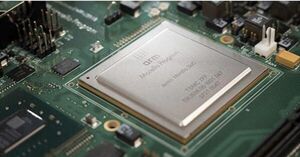
Morello research program hits major milestone with hardware now available for testing
"Securing the world’s data will be one of the greatest technology challenges over the next decade of compute. This is why Arm has been collaborating with the University of Cambridge for several years on its CHERI architecture, which defines hardware capabilities that would provide a fundamentally more secure building block for software. The Morello program, a five-year research initiative, involving a consortium led by Arm, was the result of this collaboration and aims to design a new, inherently more secure, Arm-based computing platform for the future. As a major part of this comprehensive research project, Arm has designed and built a system on a chip (SoC) and demonstrator board which contains the first example of the Morello prototype architecture. The Morello prototype boards are now being released, on schedule, and are ready for software developers and security specialists to start using the Morello architecture to demonstrate the enhanced security that can be achieved with hardware capabilities. A closer look at the new Morello prototype board The limited-edition boards are based on the Morello prototype architecture embedded into an Armv8.2-A processor (an adaptation of the Arm Neoverse N1 processor)." [...]

Nexperia’s 50 µA Zener diodes portfolio extends battery-time and saves PCB space
"Nijmegen -- The comprehensive product range covers every application from 1.8 V to 75 V Nexperia, the expert in essential semiconductors, today announced a comprehensive range of low current voltage regulator diodes. The 50 µA Zener diode range is available in three different surface-mountable (SMD) package options, in an ultra-small Discretes Flat No-leads (DFN) package and AEC-Q101 qualified parts, providing the ultimate in customer choice and flexibility. Specified at a low test current (50 μA), the efficient diodes are ideal for low bias and portable battery-powered devices in mobile, wearable, automotive and industrial applications. “The DFN1006BD-2 packaged parts with side-wettable flanks (SWF) address the concerns of various sectors, such as size, performance and ruggedness, and match many diverse applications,” says Paula Stümer, product manager at Nexperia. “Covering a wide 1.8 V to 75 V range, we deliver the industry’s broadest 50 μA Zener diode portfolio in DFN technology. However, parts are also available in leaded SMD styles, giving customers the flexibility of choice.” With 40 new types per package option covering nominal working voltages from 1.8 V to 75 V, the range is available in the ultra-low profile surface-mountable SOT23 (BZX8450), SOD323 (BZX38450) and SOD523 packages (BZX58550) and leadless DFN1006BD-2 (BZX8850S) package." [...]

Toshiba’s Newly Launched 1200V and 1700V Silicon Carbide MOSFET Modules will Contribute to Smaller, More Efficient Industrial Equipment
"Toshiba Electronic Devices & Storage Corporation (“Toshiba”) has launched two silicon carbide (SiC) MOSFET Dual Modules: “MG600Q2YMS3,” with a voltage rating of 1200V and drain current rating of 600A; and “MG400V2YMS3,” with a voltage rating of 1700V and drain current rating of 400A. The first Toshiba products with these voltage ratings, they join the previously released MG800FXF2YMS3 in a lineup of 1200V, 1700V and 3300V devices. The new modules have mounting compatibility with widely used silicon (Si) IGBT modules. Their low energy loss characteristics meet needs for higher efficiency and size reductions in industrial equipment, such as converters and inverters for railway vehicles, and renewable energy power generation systems. Applications - Inverters and converters for railway vehicles - Renewable energy power generation systems - Motor control equipment - High frequency DC-DC converter" [...]

Rambus Delivers PCIe 6.0 Controller for Next-Generation Data Centers
"Rambus Inc. (NASDAQ: RMBS), a premier chip and silicon IP provider making data faster and safer, today announced the availability of its PCI Express® (PCIe®) 6.0 Controller. The PCIe specification is the interconnect of choice across a broad landscape of data-intensive markets including data center, AI/ML, HPC, automotive, IoT, defense and aerospace. Optimized for power, area and latency, the Rambus PCIe 6.0 controller delivers data rates up to 64 Gigatransfers per second (GT/s) for high-performance applications. In addition, the controller provides state-of-the-art security with an Integrity and Data Encryption (IDE) engine that monitors and protects PCIe links against physical attacks. “The rapid advancement of AI/ML and data-intensive workloads requires that we continue to provide higher data rate solutions with best-in-class latency, power and area,” said Sean Fan, chief operating officer at Rambus. “As the latest addition to our portfolio of industry-leading interface IP, our PCIe 6.0 Controller offers customers an easy to integrate solution that delivers both performance and security for advanced SoCs and FPGAs.” Key features of the Rambus PCIe 6.0 Controller include: - Supports PCIe 6.0 specification including 64 GT/s data rate and PAM4 signaling - Supports fixed-sized FLITs that enable high-bandwidth efficiency - Implements low-latency Forward Error Correction (FEC) for link robustness - Internal data path size automatically scales up or down (256, 512, 1024 bits) based on max." [...]
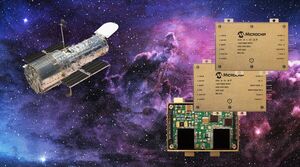
Industry’s Only Family of Standard Non-Hybrid Space-Grade Power Converters Now Includes 28 Volt (V)-Input Radiation-Tolerant Options
"Microchip’s alternatives to inflexible hybrid-style converters improve design flexibility while reducing system size, cost and development time Space system designers cannot easily support non-standard voltages or add functions with traditional hybrid-style power converters. Microchip Technology Inc. (Nasdaq: MCHP) has eliminated the cost, complexity and customization challenges of these hybrid solutions by offering a discrete-component-based, space-grade DC-DC power converter family that now includes 28V-input, 50-watt (W) radiation-tolerant options. “Our latest 28V-input SA50-28 products greatly simplify and accelerate system development,” said Leon Gross, vice president of Microchip’s discrete product business unit. “They are easier to customize than alternative space-grade power converters so they can meet specific voltage, current and other needs. Customers gain flexibility while reducing the size, cost and complexity of their space system designs.” Microchip’s SA50-28 family is the industry’s only off-the-shelf, 28V-input, radiation-tolerant power converter offering that is based on discrete components with surface-mount construction and non-hybrid assembly processes. Delivering more capabilities than alternative off-the-shelf, space-grade power converters, a single SA50-28 device with customized parameters eliminates the volume, weight and complexity problems of using hybrid solutions with their multiple devices and surrounding circuitry." [...]

Panasonic develops mass production technology for Far-Infrared Aspherical Lens with the *world's first integrated frame
"Panasonic Corporation today announced that it has developed a technology for the mass production of far-infrared aspherical lenses suitable for improving the performance of cameras and sensors. These lenses are made of chalcogenide glass having excellent transmission characteristics in the far-infrared. In addition to realizing low-cost (approx. half compared to the company’s conventional method) by newly developed glass molding method and mold processing technology, Panasonic is now able to offer a variety of lenses such as diffractive lens, the world's first* highly hermetic frame-integrated lens without using adhesive (leak detection accuracy of less than 1x10-9 Pa・m3/sec in helium leak test). The company is now accepting prototype orders. By realizing mass production of low-cost and high-quality far-infrared aspherical lenses, the company will contribute to the spread and higher performance of far-infrared sensor modules." [...]

Samsung Introduces Smart All-in-One Fingerprint Security IC for Biometric Payment Cards
"The new security IC solution combines a fingerprint sensor, Secure Element and Secure Processor in one chip, with enhanced security features enabled by Samsung’s proprietary fingerprint authentication algorithm and anti-spoofing technology Samsung Electronics, a world leader in advanced semiconductor technology, today introduced its new fingerprint security IC (integrated circuit) ─ S3B512C ─ with enhanced security features. The new solution is EMVCo and Common Criteria Evaluation Assurance Level (CC EAL) 6+ certified and performs in line with Mastercard’s latest Biometric Evaluation Plan Summary (BEPS) specifications for biometric payment cards. “S3B512C combines a fingerprint sensor, Secure Element (SE) and Secure Processor, adding an extra layer of authentication and security in payment cards,” said Kenny Han, Vice President of System LSI Marketing at Samsung Electronics. “The S3B512C is primarily designed for payment cards but can also be used in cards that require highly secured authentications such as student or employee identification, membership or building access.” The new security IC is the industry’s first all-in-one security chip solution that reads biometric information through a fingerprint sensor, stores and authenticates encrypted data with a tamper-proof SE, and analyzes and processes data with a Secure Processor. With the three key functions integrated in a single chip, the S3B512C can help card manufacturers reduce the number of chips required and optimize card design processes for biometric payment cards. With the new security IC embedded, biometric payment cards will allow faster and safer interactions when making purchases." [...]
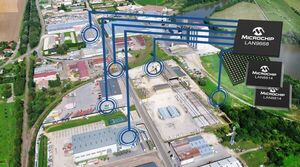
New Family of Time Sensitive Networking (TSN) Ethernet Switches Provides Industry’s First Turnkey Solution for Industrial Automation Networks
"Microchip’s LAN9668x family of Ethernet switches enables single network architecture and, combined with its new LAN8814 PHYs, reduces system cost and risk for designers while speeding time to market Factory automation is increasing efficiencies, from reducing handling and storage to improving throughput. Connected warehouses and other industrial ecosystems with converged Information Technology (IT) and Operational Technology (OT) architectures rely on Time Sensitive Networking (TSN) and Ethernet for precise timing, synchronization and connectivity of devices including cameras, bar code readers, scanners and conveyors. These ecosystems require next-generation network technology to interconnect device, sensor and equipment communication. To meet this requirement, Microchip Technology Inc. (Nasdaq: MCHP) today announced the LAN9668 family of TSN switching devices delivering IEEE standards-compliant features in the industry’s first switching solution enabling lower latency data traffic flows and greater clock accuracy. Complementing the LAN9668x is Microchip’s newly released LAN8814 quad-port Gigabit Ethernet Physical Layer (PHY) transceiver. Microchip’s LAN9668-I/9MX and LAN9668-9MX devices are 8-port switches for industrial and commercial applications, respectively, outfitted with Arm® Cortex®-A7 central processing units (CPUs), supporting TSN IEEE standards for communication in industrial settings." [...]

Orbital Insertion Burn a Success, Webb Arrives at L2
"Today, at 2 p.m. EST, Webb fired its onboard thrusters for nearly five minutes (297 seconds) to complete the final postlaunch course correction to Webb’s trajectory. This mid-course correction burn inserted Webb toward its final orbit around the second Sun-Earth Lagrange point, or L2, nearly 1 million miles away from the Earth. The final mid-course burn added only about 3.6 miles per hour (1.6 meters per second) – a mere walking pace – to Webb’s speed, which was all that was needed to send it to its preferred “halo” orbit around the L2 point. “Webb, welcome home!” said NASA Administrator Bill Nelson. “Congratulations to the team for all of their hard work ensuring Webb’s safe arrival at L2 today. We’re one step closer to uncovering the mysteries of the universe." [...]
Ciência e Tecnologia

Quantum dots boost perovskite solar cell efficiency and scalability
"Scientists at EPFL have boosted the efficiency and scalability of perovskite solar cells by replacing their electron-transport layers with a thin layer of quantum dots. Perovskites are hybrid compounds made from metal halides and organic constituents. They show great potential in a range of applications, e.g. LED lights, lasers, and photodetectors, but their major contribution is in solar cells, where they are poised to overtake the market from their silicon counterparts. One of the obstacles facing the commercialization of perovskite solar cells is that their power-conversion efficiency and operational stability drop as they scale up, making it a challenge to maintain high performance in a complete solar cell. The problem is partly with the cell’s electron-transport layer, which ensures that the electrons produced when the cell absorbs light will transfer efficiently to the device’s electrode." [...]

Fastest-ever study of how electrons respond to X-rays performed
"A study of electron dynamics timed to millionths of a billionth of a second reveals the damage radiation can do on a molecular level. The first-of-its kind study used ultrafast X-ray laser pulses to disrupt the electrons in a molecule of nitrous oxide and measure the resultant changes with unprecedented accuracy. The work, published today in Science, was performed at the Linac Coherent Light Source (LCLS) at the Stanford Linear Accelerator Centre (SLAC), Stanford, USA and was supported by a team of five scientists from Imperial College London. Conventional X-rays used in imaging and radiotherapy can cause damage to cells, but exactly how on a molecular level is not known. Additionally, new high-intensity and short-pulse-duration X-ray lasers are being proposed to image smaller molecules with greater precision, leading to questions about potential damage this could cause to living tissue. For the first time, researchers have been able to measure the behaviour of electrons in a molecule as it responded to irradiation by ultrafast X-rays on attosecond timescales – less than millionths of a billionth of a second." [...]
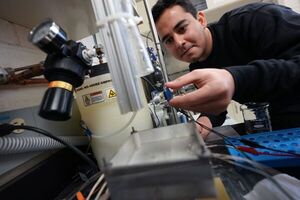
Using ice to boil water: Researcher makes heat transfer discovery that expands on 18th century principle
"Associate Professor Jonathan Boreyko and graduate fellow Mojtaba Edalatpour have made a discovery about the properties of water that could provide an exciting addendum to a phenomenon established over two centuries ago. The discovery also holds interesting possibilities for cooling devices and processes in industrial applications using only the basic properties of water. Their work was published on Jan. 21 in the journal Physical Review Fluids. Water can exist in three phases: a frozen solid, a liquid, and a gas. When heat is applied to a frozen solid, it becomes a liquid. When applied to the liquid, it becomes vapor." [...]
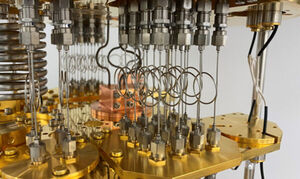
Faster technique for resetting quantum circuits proposed
"Simulations suggest a new technique for resetting ‘qubits’ in a quantum computer without harming them Rebooting a quantum computer is a tricky process that can damage its parts, but now two RIKEN physicists have proposed a fast and controllable way to hit reset1. Conventional computers process information stored as bits that take a value of zero or one. The potential power of quantum computers lies in their ability to process ‘qubits’ that can take a value of zero or one—or be some fuzzy mix of both simultaneously. “However, to reuse the same circuit for multiple operations, you have to force the qubits back to zero fast,” says Jaw Shen Tsai, a quantum physicist at the RIKEN Center for Quantum Computing. But that is easier said than done. One of the best current ways to hit reset for qubits built from tiny superconductors is to link the qubit to a photon—a particle of light—in a tiny device called a resonator." [...]
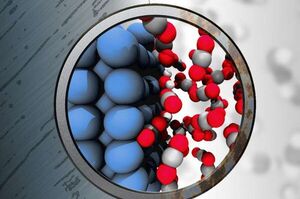
Rusting iron can be its own worst enemy
"Rice team’s simulations show iron catalyzes corrosion in 'inert' carbon dioxide Iron that rusts in water theoretically shouldn’t corrode in contact with an “inert” supercritical fluid of carbon dioxide. But it does. The reason has eluded materials scientists to now, but a team at Rice University has a theory that could contribute to new strategies to protect iron from the environment. Materials theorist Boris Yakobson and his colleagues at Rice’s George R. Brown School of Engineering found through atom-level simulations that iron itself plays a role in its own corrosion when exposed to supercritical CO2 (sCO2) and trace amounts of water by promoting the formation of reactive species in the fluid that come back to attack it. In their research, published in the Cell Press journal Matter, they conclude that thin hydrophobic layers of 2D materials like graphene or hexagonal boron nitride could be employed as a barrier between iron atoms and the reactive elements of sCO2. Rice graduate student Qin-Kun Li and research scientist Alex Kutana are co-lead authors of the paper." [...]

Scientists make first detection of exotic “X” particles in quark-gluon plasma
"The findings could redefine the kinds of particles that were abundant in the early universe. In the first millionths of a second after the Big Bang, the universe was a roiling, trillion-degree plasma of quarks and gluons — elementary particles that briefly glommed together in countless combinations before cooling and settling into more stable configurations to make the neutrons and protons of ordinary matter. In the chaos before cooling, a fraction of these quarks and gluons collided randomly to form short-lived “X” particles, so named for their mysterious, unknown structures. Today, X particles are extremely rare, though physicists have theorized that they may be created in particle accelerators through quark coalescence, where high-energy collisions can generate similar flashes of quark-gluon plasma. Now physicists at MIT’s Laboratory for Nuclear Science and elsewhere have found evidence of X particles in the quark-gluon plasma produced in the Large Hadron Collider (LHC) at CERN, the European Organization for Nuclear Research, based near Geneva, Switzerland. The team used machine-learning techniques to sift through more than 13 billion heavy ion collisions, each of which produced tens of thousands of charged particles." [...]

New Technique Boosts Efficiency, Sustainability of Large-Scale Perovskite Solar Cells
"An international team of researchers has demonstrated a technique for producing perovskite photovoltaic materials on an industrial scale, which will reduce the cost and improve the performance of mass-produced perovskite solar cells. The technique is low-cost, simple, energy-efficient, and should pave the way for creating perovskite solar cells. Perovskite is of interest for solar cells because it absorbs light very efficiently. This allows for the creation of lightweight, flexible solar cells that can be incorporated into a range of technologies, such as the windows of buildings or vehicles. “In the lab, researchers produce perovskite photovoltaic materials using a technique called spin coating, which creates a thin film of perovskite on a substrate – but only on a small scale,” says Aram Amassian, co-corresponding author of a paper on the work and a professor of materials science and engineering at North Carolina State University. “We’re talking about sample substrates that are only one or two centimeters square." [...]
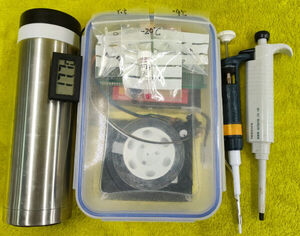
Scientists develop Covid-19 testing lab in a backpack
"Researchers have created a simple Covid-19 testing lab that fits into a backpack providing a cheap and effective solution for low income or remote areas. In a new study, published in PLOS ONE, scientists from Queen Mary University of London show that their lab-in-a-backpack approach is as effective as commercially available Covid-19 tests at detecting SARS-CoV-2. The compact kit is relatively inexpensive to make, costing $51 in total. It could offer an alternative testing solution for resource-poor countries or remote areas with little access to well-equipped testing labs or trained personnel to process samples. The testing kit is based on a simple, non-invasive Covid-19 LAMP test and uses low-cost hardware, including a centrifuge made from recycled computer hard drives, called a CentriDrive, to process samples. The LAMP test is a widely accepted alternative to the commonly used PCR test, has a similar sensitivity but unlike the PCR test does not require temperature cycling, only a single high temperature to amplify any potential virus RNA." [...]
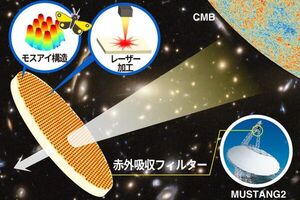
Scientists Make a New Type of Optical Device Using Alumina
"Scientists from the Kavli Institute for the Physics and Mathematics of the Universe and the University of Minnesota, Tomotake Matsumura and Shaul Hanany, and their collaborators have made a new type of optical element that will improve the performance of telescopes studying radiation from the Big Bang. The cosmic microwave background (CMB) is a relic radiation remnant from the big bang. It reaches our telescopes after traveling 14 billion years since the birth of the Universe. Studying the properties of this radiation, scientists infer the physics of the big bang, how clusters of galaxies form, and the matter and energy content in the Universe. Four Nobel prizes have been awarded for past studies of the CMB. To study the CMB, telescopes must be tuned to wavelengths in which it is most intense, about 1-3 mm, and they must separate out shorter wavelength radiation that the atmosphere and Milky Way emit." [...]

Hope for Present-Day Martian Groundwater Dries Up
"Liquid water previously detected under Mars’ ice-covered south pole is probably just a dusty mirage, according to a new study of the red planet led by researchers at The University of Texas at Austin. Scientists in 2018 had thought they were looking at liquid water when they saw bright radar reflections under the polar cap. However, the new study published Jan. 24 in the journal Geophysical Research Letters found that the reflections matched those of volcanic plains found all over the red planet’s surface. The researchers think their conclusion — volcanic rock buried under ice — is a more plausible explanation for the 2018 discovery, which was already in question after scientists calculated the unlikely conditions needed to keep water in a liquid state at Mars’ cold, arid south pole. “For water to be sustained this close to the surface, you need both a very salty environment and a strong, locally generated heat source, but that doesn’t match what we know of this region,” said the study’s lead author, Cyril Grima, a planetary scientist at the University of Texas Institute for Geophysics (UTIG). The south polar mirage dissolved when Grima added an imaginary global ice sheet across a radar map of Mars." [...]
Tracking quantum phenomena in 2D graphene
"In recent years, a phenomenon called the quantum Hall effect has emerged as a platform for hosting exotic features called quasiparticles, with properties that could lead to exciting applications in areas like quantum computing. When a strong magnetic field is applied to a 2D material or gas, the electrons at the interface – unlike the ones within the bulk – are free to move along the edges in what are called edge modes or channels – somewhat similar to highway lanes. This edge movement, which is the essence of the quantum Hall effect, can lead to many interesting properties depending on the material and conditions. For conventional electrons, the current flows only in one direction dictated by the magnetic field (‘downstream’). However, physicists have predicted that some materials can have counter-propagating channels where some quasiparticles can also travel in the opposite (‘upstream’) direction. Although these upstream channels are of great interest to scientists because they can host a variety of new kinds of quasiparticles, they have been extremely difficult to identify because they do not carry any electrical current." [...]
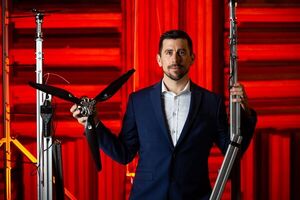
UC engineers a quieter future for drones, flying cars
"One obstacle to realizing the dream of flying cars is noise — imagine 1,000 leaf blowers intruding over your backyard barbecue. It’s not just flying cars but drones as well. Complaints about the high-pitched keening of propellers could lead to restrictions or regulations that could hamper the growth of a new commercial drone industry. University of Cincinnati aerospace engineering students are studying solutions to dampen sound in assistant professor Daniel Cuppoletti’s lab in UC’s College of Engineering and Applied Science. If flying cars are to succeed, Cuppoletti said, they'll have to be quiet. UC aerospace engineering students Natalie Reed, Matthew Walker and Peter Sorensen presented papers with Cuppoletti at the Science and Technology Forum and Exposition this month in San Diego, California." [...]
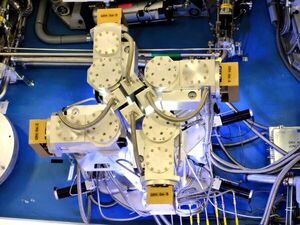
New experiment results bolster potential for self-sustaining fusion
"For more than 60 years, scientists have sought to understand and control the process of fusion, a quest to harness the vast amounts of energy released when nuclei in fuel come together. A paper published today in the journal "Nature" describes recent experiments that have achieved a burning plasma state in fusion, helping steer fusion research closer than it has ever been to its ultimate goal: a self-sustaining, controlled reaction. Los Alamos National Laboratory researchers, including members of the Physics division, contributed essential capabilities in diagnostic science to achieve and analyze the unprecedented results. Their diagnostic advances helped transition fusion research to its current era at the threshold of ignition — the point at which a fusion reaction generates more energy than it receives and can burn on its own. “These experiments indicate a transition to a different physics regime,” said Los Alamos physicist Hermann Geppert-Kleinrath, a member of the team at the National Ignition Facility working on the burning plasma project. “The research described in this paper marks where alpha heating in the reactions outcompeted the loss between radiation and heat conduction." [...]

Smart memory devices that can sense
"In-memory sensing technology will facilitate electronic systems that are faster, smaller and consume less energy. Smart systems and environments of the future will require merging analog sensing and digital memory functions into single electronic components, suggests KAUST computing engineer Nazek El-Atab. “In-memory sensing,” as the infant technology is called, will use integrated “MemSor” devices that are directly programed by the intensity of external stimulus acting on them, achieving dramatic improvements in speed, miniaturization and energy consumption. “We are introducing a new concept,” explains El-Atab, lead author of the paper. “Over the coming months, we want to publish original research to present our results in the field.” To create faster devices, component engineers have, until recent years, simply crammed more transistors onto the chips they design. With this strategy now reaching its physical limits, they have been developing more streamlined computer architectures." [...]
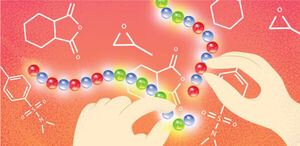
One pot wonder for polymer diversity
"A catalyst turns three monomer mixtures into diblock dialternating terpolymers in a single step. A catalyst developed at KAUST could be the key to structural diversity in polymer materials and industrial-scale polymerizations involving multiple monomers. The catalyst transforms a mixture of three monomers into well-defined, ordered diblock terpolymers in one step. Block copolymers comprise at least two polymer segments, each derived from different monomer species, combining the properties of these segments in the same molecule. This makes them appealing for a wide range of applications, from the development of thermoplastics to biomaterials for drug delivery. Chemists have relied on two-step polymerizations in one or two separate vessels to synthesize block copolymers." [...]
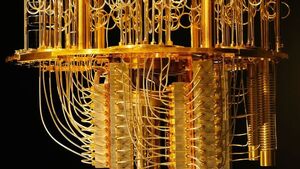
A new language for quantum computing
"Twist is an MIT-developed programming language that can describe and verify which pieces of data are entangled to prevent bugs in a quantum program. Time crystals. Microwaves. Diamonds. What do these three disparate things have in common? Quantum computing." [...]
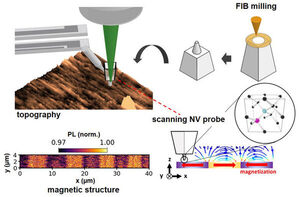
Towards Superior Nanoscale Sensing and Imaging with Optimized Diamond Probes
"Researchers propose an alternate fabrication method for diamond probes with greater control over probe shape, higher sensitivity, and broader applications Miniaturized magnetic devices and new spintronic devices require detailed imaging at nanoscales, where quantum properties become important. However, the imaging resolution is limited by the size of magnetic probe. Now, researchers from Japan offer a method for manufacturing scanning diamond probes with more processing flexibility unlike conventional techniques and greater control over their shape, paving the way for high-performance nano-quantum sensing and imaging. From the discovery of microorganisms in the field of biology to imaging atoms in the field of physics, microscopic imaging has improved our understanding of the world and has been responsible for many scientific advances. Now, with the advent of spintronics and miniature magnetic devices, there is a growing need for imaging at nanometer scales to detect quantum properties of matter, such as electron spins, magnetic domain structure in ferromagnets, and magnetic vortices in superconductors. Typically, this is done by complementing standard microscopy techniques, such as scanning tunneling microscopy and atomic force microscopy (AFM), with magnetic sensors to create "scanning magnetometry probes" that can achieve nanoscale imaging and sensing." [...]

Lancaster physicist solves century old problem of radiation reaction
"A Lancaster physicist has proposed a radical solution to the question of how a charged particle, such as an electron, responds to its own electromagnetic field. This question has challenged physicists for over 100 years but mathematical physicist Dr Jonathan Gratus has suggested an alternative approach - published in the Journal of Physics A- with controversial implications. It is well established that if a point charge accelerates it produces electromagnetic radiation. This radiation has both energy and momentum, which must come from somewhere. It is usually assumed that they come from the energy and momentum of the charged particle, damping the motion. The history of attempts to calculate this radiation reaction (also known as radiation damping) date back to Lorentz in 1892." [...]

HKUST researchers find new way of gaining quantum control from loss
"Researchers at the Hong Kong University of Science and Technology (HKUST) have demonstrated a new way to control the quantum state through the loss of particles – a process that is usually avoided in the quantum device, offering a new way towards the realization of unprecedented quantum states. Manipulating a quantum system requires a subtle control of quantum state with zero imperfect operations, otherwise the useful information encoded in the quantum states is scrambled. One of the most common detrimental processes is the loss of particles that consist of the system. This issue has long been seen as an enemy of quantum control and was avoided through the isolation of the system. But now, researchers at the HKUST have discovered a way that could gain quantum control from loss in an atomic quantum system. The finding was published today in Nature Physics." [...]
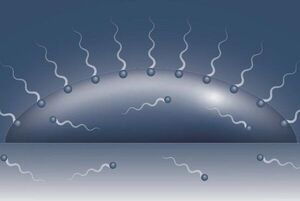
Improving print quality by using surfactants
"Ruben van Gaalen found out how to avoid the 'coffee-stain effect' when droplets dry up, so that printing companies can develop ink more efficiently. Have you ever spilled coffee onto a table? If so, you have probably noticed that the resulting stain is not nicely uniform but has a notable ring around it. This forgettable oddity is daily business in the printing industry, where such a drying pattern is detrimental to the final quality. Mechanical engineer Ruben van Gaalen investigated this problem by focusing on a promising solution: the use of surfactant molecules. The drying of a droplet on a substrate is a complicated process." [...]
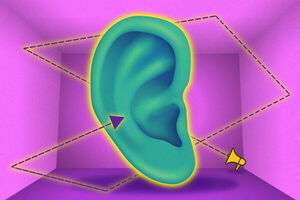
Where did that sound come from?
"MIT neuroscientists have developed a computer model that can answer that question as well as the human brain. The human brain is finely tuned not only to recognize particular sounds, but also to determine which direction they came from. By comparing differences in sounds that reach the right and left ear, the brain can estimate the location of a barking dog, wailing fire engine, or approaching car. MIT neuroscientists have now developed a computer model that can also perform that complex task. The model, which consists of several convolutional neural networks, not only performs the task as well as humans do, it also struggles in the same ways that humans do. “We now have a model that can actually localize sounds in the real world,” says Josh McDermott, an associate professor of brain and cognitive sciences and a member of MIT’s McGovern Institute for Brain Research." [...]

Bone growth inspired “microrobots” that can create their own bone
"Inspired by the growth of bones in the skeleton, researchers at the universities of Linköping in Sweden and Okayama in Japan have developed a combination of materials that can morph into various shapes before hardening. The material is initially soft, but later hardens through a bone development process that uses the same materials found in the skeleton. When we are born, we have gaps in our skulls that are covered by pieces of soft connective tissue called fontanelles. It is thanks to fontanelles that our skulls can be deformed during birth and pass successfully through the birth canal. Post-birth, the fontanelle tissue gradually changes to hard bone. Now, researchers have combined materials which together resemble this natural process." [...]
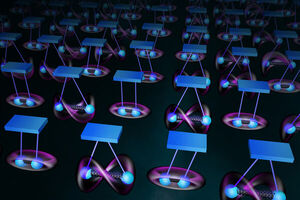
Vibrating atoms make robust qubits, physicists find
"The new qubits stay in “superposition” for up to 10 seconds, and could make a promising foundation for quantum computers. MIT physicists have discovered a new quantum bit, or “qubit,” in the form of vibrating pairs of atoms known as fermions. They found that when pairs of fermions are chilled and trapped in an optical lattice, the particles can exist simultaneously in two states — a weird quantum phenomenon known as superposition. In this case, the atoms held a superposition of two vibrational states, in which the pair wobbled against each other while also swinging in sync, at the same time. The team was able to maintain this state of superposition among hundreds of vibrating pairs of fermions. In so doing, they achieved a new “quantum register,” or system of qubits, that appears to be robust over relatively long periods of time." [...]
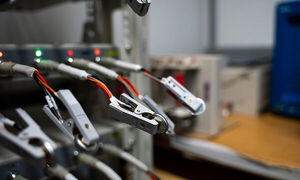
Next-generation battery research offers electric cars a boost
"UBCO’s collaboration with Fenix Advanced Materials kicks into high-gear UBC Okanagan researchers have teamed up with a BC company to create a smaller, more powerful battery than what’s currently available. The collaboration with Fenix Advanced Materials of Trail, BC, is helping researchers in UBCO’s Advanced Materials for Energy Storage Lab design and develop much improved state-of-the-art batteries. The latest published research is part of a $2-million initiative between Fenix, Mitacs and UBC Okanagan. The research investment strengthens Canada’s position in emerging solid-state battery innovation and accelerates electric vehicle (EV) deployment and renewable energy opportunities, says Dr. Jian Liu, an Assistant Professor in the School of Engineering. “Advancements in solid-state batteries are propelling the EV industry forward along with the added benefit of advancing emerging devices in medicine and communications,” explains Dr. Liu. “All-solid-state, lithium-tellurium batteries enable higher energy output with an improved safety rating inside a smaller form-factor, thereby expanding its possible applications.” In order for a battery to work, it needs to store chemical energy and convert it into electrical energy." [...]

Asymmetry is key to creating more stable blue perovskite LEDs
"From street and household lighting, to television and mobile displays, light emitting diodes (LEDs) play an essential role in modern life. Now, researchers from the Okinawa Institute of Science and Technology Graduate University (OIST) have developed blue LEDs based on a material called metal halide perovskite, that, for the first time, uses asymmetrical bridges to hold the layers of perovskite together, creating a more stable structure. The study, published recently in the Journal of the American Chemical Society on November 18th 2021, could bring perovskite LEDs one step closer to commercialization. “Perovskites have the potential to be a real game-changer in the lighting industry,” said first author Dr. Yuqiang Liu, a former post-doctoral researcher in the OIST Energy Materials and Surface Sciences Unit and currently a professor at Qingdao University, China. “In only a few short years, the efficiency of perovskite LEDs – how well they can transfer electrical energy into light energy – has shot up to a level that rivals traditional LEDs, and soon will surpass them.” Aside from efficiency levels, perovskite LEDs also have numerous advantages over current LED technologies on the market, as they have the potential to produce brighter, purer colors at a fraction of the production cost. However, the stability of perovskite LEDs remains a huge barrier, with the operational lifetime of even the most stable LEDs lasting only a few hundred hours." [...]

Demystifying machine-learning systems
"A new method automatically describes, in natural language, what the individual components of a neural network do. Neural networks are sometimes called black boxes because, despite the fact that they can outperform humans on certain tasks, even the researchers who design them often don’t understand how or why they work so well. But if a neural network is used outside the lab, perhaps to classify medical images that could help diagnose heart conditions, knowing how the model works helps researchers predict how it will behave in practice. MIT researchers have now developed a method that sheds some light on the inner workings of black box neural networks. Modeled off the human brain, neural networks are arranged into layers of interconnected nodes, or “neurons,” that process data. The new system can automatically produce descriptions of those individual neurons, generated in English or another natural language." [...]

Mysterious Object Unlike Anything Astronomers Have Seen Before
"A team mapping radio waves in the Universe has discovered something unusual that releases a giant burst of energy three times an hour, and it’s unlike anything astronomers have seen before. The team who discovered it think it could be a neutron star or a white dwarf—collapsed cores of stars—with an ultra-powerful magnetic field. Spinning around in space, the strange object sends out a beam of radiation that crosses our line of sight, and for a minute in every twenty, is one of the brightest radio sources in the sky. Astrophysicist Dr Natasha Hurley-Walker, from the Curtin University node of the International Centre for Radio Astronomy Research, led the team that made the discovery. “This object was appearing and disappearing over a few hours during our observations,” she said. “That was completely unexpected." [...]
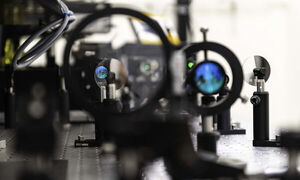
Using nanodiamonds as sensors just got easier
"Rochester researchers find new way to extract temperature from light emitted by a diamond defect. For centuries people have placed the highest value on diamonds that are not only large but flawless. Scientists, however, have discovered exciting new applications for diamonds that are not only incredibly small but have a unique defect. In a recent paper in Applied Physics Letters, researchers at the University of Rochester describe a new way to measure temperature with these defects, called nitrogen vacancy centers, using the light they emit. The technique, adapted for single nanodiamonds by Andrea Pickel, assistant professor of mechanical engineering, and Dinesh Bommidi, a PhD student in her lab, allowed them to precisely measure, for the first time, the duration of these light emissions, or “excited state lifetimes,” at a broad range of temperatures. The discovery earned the paper recognition as an American Institute of Physics “Scilight,” a showcase of what AIP considers the most interesting research across the physical sciences." [...]
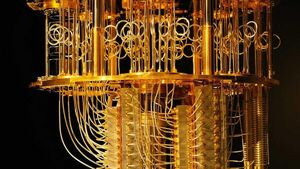
Scientists simulate ‘fingerprint’ of noise on quantum computer
"Unique study could point way to new approach, uses for quantum technology For humans, background noise is generally just a minor irritant. But for quantum computers, which are very sensitive, it can be a death knell for computations. And because “noise” for a quantum computer increases as the computer is tasked with more complex calculations, it can quickly become a major obstacle. But because quantum computers could be so incredibly useful, researchers have been experimenting with ways to get around the noise problem. Typically, they try to measure the noise in order to correct for it, with mixed success. A group of scientists from the University of Chicago and Purdue University collaborated on a new technique: Instead of directly trying to measure the noise, they instead construct a unique “fingerprint” of the noise on a quantum computer as it is seen by a program run on the computer." [...]

The "door opener" for 3D printing in automotive series production
"With approximately 50 percent lower cost and 35 percent weight savings compared to the equivalent milled part, a redesign of the arm of a door hinge for a high-profile sports car shows that innovation with additive manufacturing is economically feasible! This is made possible thanks to 3D printing-centred design methods developed by specialists at Fraunhofer IAPT. The advantages of additive manufacturing (AM) best come in play when components are designed from the ground up specifically for this process. This fact is well-known. But how this aspect, combined with other optimization measures, can positively influence both the technical properties and the costs of the finished component, may come as a surprise to even some experts. Now, Fraunhofer IAPT has carried out a redesign project using the example of a sports car door hinge to identify, step by step, the factors that influence the component´s cost." [...]

How a Smart Electric Grid Will Power Our Future
"A novel plan that offers partnership in keeping the United States electric grid stable and reliable could be a win-win for consumers and utility operators. The largest ever simulation of its kind, modeled on the Texas power grid, concluded that consumers stand to save about 15 percent on their annual electric bill by partnering with utilities. In this system, consumers would coordinate with their electric utility operator to dynamically control big energy users, like heat pumps, water heaters and electric vehicle charging stations. This kind of flexible control over energy supply and use patterns is called “transactive” because it relies on an agreement between consumers and utilities. But a transactive energy system has never been deployed on a large scale, and there are a lot of unknowns. That’s why the Department of Energy’s Office of Electricity called upon the transactive energy experts at Pacific Northwest National Laboratory to study how such a system might work in practice." [...]

Researchers Develop Eminent Quantum Gate Testing Method
"The development of quantum technology is currently one of the most popular frontiers of advanced science, and is considered as a significant indicator of a country’s sci-tech level. On a structural basis, a quantum computer consists of multiple quantum gates. Fault-tolerant quantum computation requires high-fidelity operation on the gates, stressing the priority of developing a reliable and efficient way to examine the fidelity of prepared quantum gates. Recently, the research group led by Academician GUO Guangcan from the University of Science and Technology of China (USTC) of the Chinese Academy of Sciences, made great progress in developing techniques of measuring and examining quantum gates. Related work was published in Physical Review Letters. Due to the exponential growth of measurements and computation, the traditional quantum state tomography method no longer remains its practicability as the future of quantum technology lies in the gates and routes of large scale." [...]
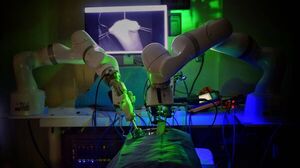
Robot Performs First Laparoscopic Surgery Without Human Help
"A robot has performed laparoscopic surgery on the soft tissue of a pig without the guiding hand of a human—a significant step toward fully automated surgery on humans. Designed by a team of Johns Hopkins University researchers, the Smart Tissue Autonomous Robot, or STAR, is described today in Science Robotics. "Our findings show that we can automate one of the most intricate and delicate tasks in surgery: the reconnection of two ends of an intestine. The STAR performed the procedure in four animals and it produced significantly better results than humans performing the same procedure," said senior author Axel Krieger, an assistant professor of mechanical engineering at Johns Hopkins' Whiting School of Engineering. The robot excelled at intestinal anastomosis, a procedure that requires a high level of repetitive motion and precision. Connecting two ends of an intestine is arguably the most challenging step in gastrointestinal surgery, requiring a surgeon to suture with high accuracy and consistency." [...]

Getting hydrogen out of banana peels
"Scientists at EPFL have developed a way to maximize hydrogen yields from biowaste within a few milliseconds. The method uses rapid photo-pyrolysis to produce hydrogen gas and solid conductive carbon from banana peels. As the world’s energy demands increase, so does our consumption of fossil fuels. The result is a massive rise in greenhouse gases emissions with severely adverse environmental effects. To address this, scientists have been searching for alternative, renewable sources of energy. A main candidate is hydrogen produced from organic waste, or “biomass”, of plants and animals." [...]

Scientists make first detection of exotic “X” particles in quark-gluon plasma
"The findings could redefine the kinds of particles that were abundant in the early universe. In the first millionths of a second after the Big Bang, the universe was a roiling, trillion-degree plasma of quarks and gluons — elementary particles that briefly glommed together in countless combinations before cooling and settling into more stable configurations to make the neutrons and protons of ordinary matter. In the chaos before cooling, a fraction of these quarks and gluons collided randomly to form short-lived “X” particles, so named for their mysterious, unknown structures. Today, X particles are extremely rare, though physicists have theorized that they may be created in particle accelerators through quark coalescence, where high-energy collisions can generate similar flashes of quark-gluon plasma. Now physicists at MIT’s Laboratory for Nuclear Science and elsewhere have found evidence of X particles in the quark-gluon plasma produced in the Large Hadron Collider (LHC) at CERN, the European Organization for Nuclear Research, based near Geneva, Switzerland. The team used machine-learning techniques to sift through more than 13 billion heavy ion collisions, each of which produced tens of thousands of charged particles." [...]
Documentação
A documentação é parte essencial do processo de aprendizagem e a Internet além de artigos interessantes de explorar também tem alguma documentação em formato PDF interessante de ler. Todos os links aqui apresentados são para conteúdo disponibilizado livremente pelo editor do livro.
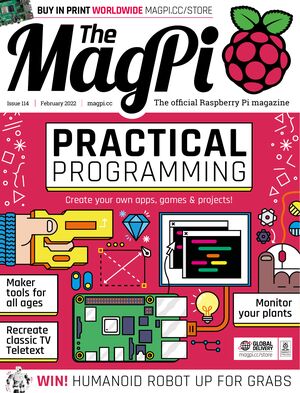
The MagPi 114
"Discover the art of programming and put code to work in the latest edition of The MagPi magazine. Inside The MagPi magazine issue #114 - Practical Programming. Build better projects by developing your coding skills. - Maker Tools. Discover all the gadgets you need to make better projects in 2022. - Create a Teletext television." [...]
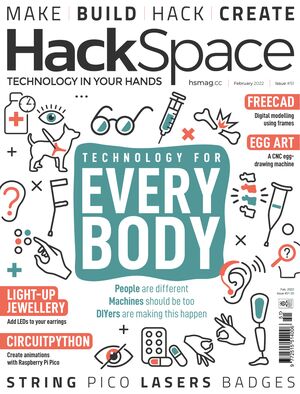
HackSpace magazine #51
"Human beings come in all shapes and sizes, all abilities and disabilities. So why should we have to fit in with technology, when technology can so easily be changed to suit us? That’s the key question that unites the projects in this issue. From joystick adaptations to prosthetic limbs, we take a look at the ways that open source hardware is making life better for millions of people. - Make shiny LED jewellery - Explore the Inception-like properties of hexaflexagons - Design for pipes in FreeCAD - Our most ambitious make yet: building a laser cutter from scratch! " [...]
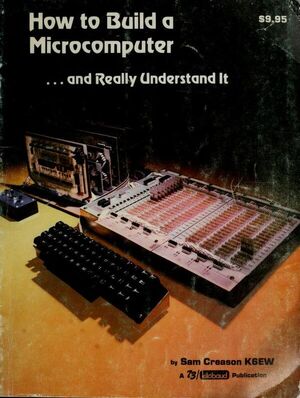
How to Build a Microcomputer … and Really Understand it
"An early book on a 6502 microcomputer. Around the 6502 and parts from the 1979 period. Interesting is the diode matrix based ‘PROM’. Very well written and gives lots of insight in digital logic. " [...]
Projetos Maker
Diversos Projetos interessantes.
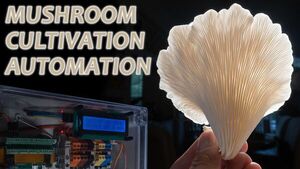
Mushroom Cultivation Automation: From Foraging To Fruiting
"Mushrooms are a unique and often mysterious organism. They’re not quite plants and not quite animals. As a fungus, mushrooms represent a distinct evolutionary lineage. Fungi grow as a single-cell yeast form (used in beer, wine, and bread making) and multi-cellular, thread-like mycelia that often produce fruiting bodies (mushrooms) and sclerotia (e.g. truffles), and are responsible for the decomposition of the vast majority of dead plant matter. Understanding life cycle of mushroom fungi is a valuable skill if you wish to harness this knowledge for mushroom cultivation." [...]
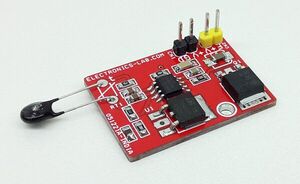
PWM Temperature Controlled FAN using TC648 and NTC sensor
"The project described here is a switch mode fan speed controller for use with brushed or brushless DC motors. Temperature proportional speed control is accomplished using pulse width modulation (PWM). 10K Ohms NTC is used to sense the temperature. The project is built using TC648 chip and configured with auto-shutdown mode. In Auto-Shutdown mode, fan operation is automatically suspended when the measured temperature is lower than 25 degrees centigrade. The fan is automatically restarted and proportional speed control is restored when the temperature exceeds 25 degrees centigrade." [...]
Silicon die teardown: a look inside an early 555 timer chip
"If you've played around with electronic circuits, you probably know the 555 timer integrated circuit,1 said to be the world's best-selling integrated circuit with billions sold. Designed by analog IC wizard Hans Camenzind2, the 555 has been called one of the greatest chips of all time. Eric Schlaepfer (@TubeTimeUS) recently came across the chip above, with a mysterious part number. He tediously sanded through the epoxy package to reveal the die (below) and determined that the chip is a 555 timer. Signetics released the 555 timer in mid-1972 4 and the chip below has a January 1973 date code (7304), so it must be one of the first 555 timers. Curiously, it is not labeled 555, so perhaps it is a prototype or internal version.3 I took detailed die photos, which I discuss in this blog post." [...]

How To Make A STAR WARS Game Using Arduino and OLED? Retro G
"It's a retro game which is made using ARDUINO, OLED AND BUZZERS. Its an amazing project for your school exhibition or for fun. This is a retro game, which consists three push buttons (UP, DOWN, FIRE), where you are in a spaceship and you have to destroy the monster. Remember that the monster also has the power to destroy your spaceship, and the game will be faster according to time! " [...]
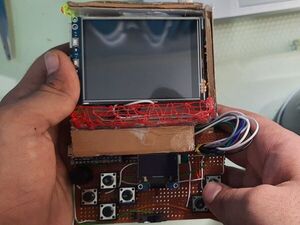
raspiduboy's dreamboy
"A handheld emulation device based on raspberry pi, that has a removable controller and the controller has a arduboy it to play it on the go. I followed mr.blinkys Arduboy homemade package standard wiring and wired an arduboy following these instructions and for each switch, I made a secondary connection that goes to the header pins, which in turn gets connected to RPI gpios when we want to use it as a controller to play games on RPI. also made a custom PCB out of protoboard. Then downloaded a game from the arduboy game website. then uploaded to it using USB wire. " [...]

PCB Heart Necklace
"Made a heart-shaped PCB Necklace for a special one <3" [...]

Artificial Life: HD
"A hugely improved and updated version of my Artificial Life project using the Pimoroni Unicorn HAT HD! The project before This is an update on a previously existing project: Artificial Life which I made way back in the old times of 2017. It is essentially running a simulation on life forms represented by LED's on a matrix and seeing how they interact and evolve. It used the original Unicorn HAT which has an 8x8 array of RGB LEDs; perfect for drawing a board of life forms to move around. It was also running on an original Pi Zero - so the processing power wasn't so good, especially for expansion of the project. It was very glitchy, the life forms could pass and overwrite each other the image blanked out for a small amount of time as each life form moved and there was tons of messy/bad code that mad PyCharm sad." [...]
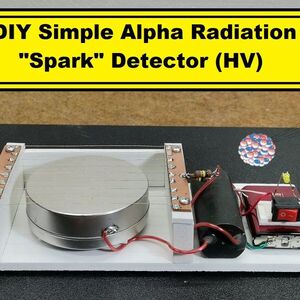
DIY Simple Alpha Radiation Spark Detector (HV)
"For detection is used high voltage (from 8000 to 15000 volts) The presence of Alpha radiation is manifested by small sparks between the anode and the cathode. This time I will show you how to make a very simple device that can detect Alpha radiation. The device is also called a Spark detector, because for detection is used high voltage (from 8000 to 15000 volts), and the presence of Alpha radiation is manifested by small sparks between the anode and the cathode. In this type of detector, thin negatively-charged wires are strung through atmospheric air above a planar anode, and sparking occurs when strongly ionizing radiation like alpha particles passes through the high-field region near the wires. The concept was first described by Chang and Rosenblum in 1945, and later it was made many times. Nowadays its making is extremely simple, thanks to these compact high voltage sources that can be purchased for a few dollars." [...]

Measuring Circuit Delay for FPGA Timing using the ADP3450
"Using the ADP3450, this project measures amount of delay between asserting FPGA IO on base of NPN 2N3094 and LED illuminating on collector. Signal timing is a huge component in FPGA design, and while many tutorials demonstrate how to handle timing within the programmable logic I thought it would be helpful to show how to measure external circuitry timing when it's being driven by an FPGA's I/O and has a direct impact on the timing of the logic in RTL. Recently I posted a project about driving a 5-digit 7-segment display with an FPGA where I had to calculate the proper refresh rate of how long a character needed to be held on each display to appear stable to the human eye. Each common cathode of the 5 7-segment displays where connected to the collector of an NPN 2N3904 BJT that were connected to ground by an I/O pin from the FPGA being set high. Thus, past of this timing of the overall refresh rate included how long it would take for the collector to be connected to the emitter (and ultimately ground) after the FPGA I/O signal was asserted. Using the oscilloscope function of my Analog Discovery Pro ADP3450 with its control interface software WaveForms, I set up a test circuit with a single 2N3904 and LED on its collector to measure the amount of delay between the FPGA I/O pin being asserted on the base of the BJT to when the LED is illuminated." [...]

DIY Arduino Tug of War Game on Homemade 8x8 Led Matrix
"Tug of War is an old game where two players pull on a rope, one player winning by pulling the rope far enough to their own side. Tug of War is an old game where two players pull on a rope, one player winning by pulling the rope far enough to their own side. Now this game is also known to the younger generations thanks to the mega-popular Korean TV series "Squid Game". Today I will show you how to make an electronic version of this game that is played on a homemade 8 on 8 Led Matrix. In this version, the two players press a button as fast as they can to pull the virtual rope to their side. The code is taken from the Andrew R McHugh GitHub page, and the hardware part differs in that the matrix is homemade and consists of 64 5mm LEDs." [...]
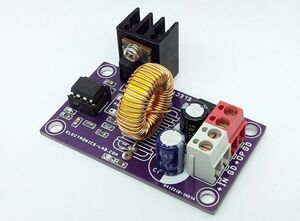
DC-HV DC Converter – 200V @ 20mA Output with 12V DC Input
"This is a low-cost DC-HV DC converter built using TL3843 Low-Power Current-Mode PWM Controller from TI. Screw terminal connectors are provided for input and output, onboard LED D1 indicates the input supply. The project provides 200V DC @ 20mA output from 12V DC supply input. FEATURES - Operating Power Supply 12V DC @ 1A (Range 10V to 15V DC) - Output 150V DC @ 50mA to 200V DC @ 20mA - Operating Frequency 40Khz - Over Current Protection - D1 Power LED - Screw Terminal Connectors for Input and Output - PCB Dimensions 61.28 x 36.04 mm" [...]

Rangoli Making Robot | Drawing Robot | Arduino Servo Robot
"This is a rangoli/sand-art-making robot. It has 2 servo motors controlled by an Arduino Uno prototyping board. It can draw different shapes. What is your project about? This project is about a robot that can draw and write on rangoli. It has two servo motors that are controlled by an Atmega328p microcontroller mounted on an Arduino Uno prototyping board." [...]

Arduino Nano 20KHz pocket sized Digital Oscilloscope
"A difficult code with a try to display waveform on a small screen with precisions. Volts-time, frequency, duty cycle and divisions. Previously, I posted a tutorial on Raspberry Pi-Pico Oscilloscope. And that was a great success. Keeping portable options in mind, I found this pretty mini oscilloscope between thousands of pages of a Japanese website. We are using a mini-OLED 128X64 to display the signal waveform, Frequency, duty cycle." [...]
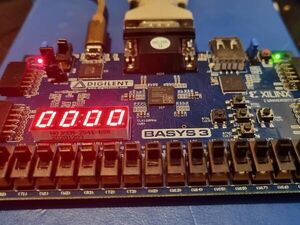
Basys3 Oscilloscope
"Creating a simple oscilloscope with the Basys3 board Introduction The Digilent Basys3 board is a very capable board to get started developing FPGA projects with. It provides the users with an Artix 35T device, USB-UART, Four Pmods - Including one configured for the XADC, 12 bit VGA and switches, LED and Seven Segment Display. This project is designed to demonstrate just how capable the Basys3 board is, to do that we are going to create a simple oscilloscope which can use the XDAC Pmod input channels and the VGA display to display the waveform. To do this we are going to use a MicroBlaze controller to run the application and control the measurement of the XADC and determine where to plot the data on the VGA screen. The VGA Display will be 640 by 480, 12 bit RGB to render this in software memory would require 3, 686, 400 bits. This exceeds the 1, 800, 000 bits of BRAM available in the FPGA." [...]
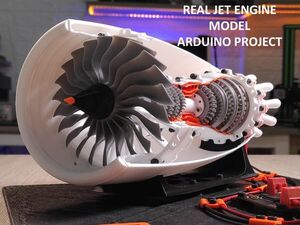
HomeMade Arduino Jet Engine
"Have you ever tried to create a real spinning Jet yourself! checkout the detailed making steps in this Hackster post. As usual I made this tutorial to guide you step by step while in case you decided to experience the same adventure and you make Your own Real Spinning Jet Engine. During the making of this project, we tried to make sure that this post will be the best guide that contains the necessary making documents and references. We've made this project in just 6 days only, just Five days to get all the needed parts and finish the hardware making and the assemble, then we have prepared the code to suit our project. Before starting let’s see first." [...]
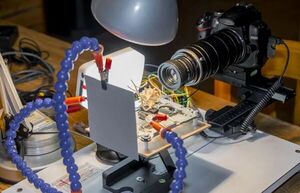
SuperMacro Photo With Cdrom/dvd Rail and Arduino
"This project reuses a motor lane from a DVD or CDROM to be able to take macro photography with fairly high precision; 1.5cm approx 99 steps => 0.015cm x step or 15 microns. 5cm => 333 steps max Rings 49mm x 2 = 98mm (with the meter gives 11cm) ... That would be 3:2 that is 1.5x . From here up to 10:1 (x10) bellows would be necessary. I have used macro lenses (Nikkor 60mm F2.8 D Micro), microscope lens with adapter and B/W enlarger lens with extensions and/or bellows.It is also possible to use an inverted lens with its adapter to flip it. "I have to say that this assembly has a drawback, what moves is the object to be photographed and not the camera, so it will have to be held tightly or it can move or fall." This is just an example of what I have used: - Arduino UNO - PCB and components - Reflex or mirrorles camera (I used Nikon d7000), It has to allow working with lenses without information (manuals) - Remote release cable for camera - An old CDROM or DVD unit, with motor (SLED) that can be continuous with pulse detector or stepper - For the stepper motor the recommended driver would be the DRV8825 (polulu) - Camera centering bracket - Bellows for your camera - Microscope lens with adaptors: - 4X Plan Achromatic Objective Lens with Knurled Ring - Interface adapter ring for RMS microscope to M42 x0.75 - Lens Mount Adapter (Type 2), M42 Lens (42mm x 1 Thread Screw) to Nikon - Or Magnifier lens (B/W Enlarger) - For example Schneider Kreuznach Componar-C F2.8 50mm - B/W enlarger lenses usually use Leica M39 thread,mount on the M42 adapter - A table 45cm x30cm (even a kitchen one), some spacers and screws." [...]

Gesture Controlled Smart Mirror
"A Smart Mirror is a two-way mirror with an inbuilt display behind the glass. The display can show anything you want on the mirror’s surface such as the current time, weather forecast, news feed, upcoming appointments, and more. In this project, we are going to build a gesture-controlled smart mirror with swipeable pages. Materials: - 1 x Raspberry Pi 4 - 1 x Monitor - 1 x Micro HDMI Male To HDMI Female Adaptor - 1 x HDMI Male to VGA Female Video Converter Adapter Cable - 1 x Male to Male VGA Cable - 1 X REES52 5 Megapixel 160° degrees Wide Angle Fish-Eye Camera - 1 x Computer Power Cable Cord for Desktops PC - 1 x Raspberry Pi 4 USB-C Official Power Supply - 5.1V 3 Amp Note: These are the electronic components required for this project. " [...]
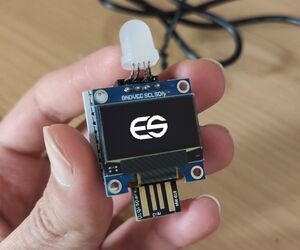
ES Timer a Special Pomodoro Timer (Digispark ATtiny85)
"ES Timer powered by Digispark ATtiny85 is based on the Pomodoro technique, which can solve the problem of skipping the break phase between work phases. When you connect it to your system port (whether Windows, Linux or even macOS) it starts to countdown when the counting is over it locks the system and this time starts counting the break phase the user cannot unlock your system at this time unless the time is overing or pull the timer out of the port. This timer, in addition to notifying the user of the LED by turning it on a few seconds before the start of the break phase, does not start the next Pomodoro without the user's approval. to start the new Pomodoro, it is enough to keystroke twice on the "Capslock'' with a delay of 1 second. Supplies - Arduino IDE - Digispark ATtiny85 - Female and male pin header standard - LED - PCB prototype board - Soldering iron and wire - SSD1306 I2C OLED - Wire Why ES Timer ES Timer has advantages and features over software or websites that you can use for the Pomodoro technique that distinguish it from other Pomodoro timers, which include: 1. Forcing to follow the breaks between tasks: With ES Timer, you no longer have an excuse not to observe breaks between your tasks, because unlike existing software, this timer does not only give a warning to stop working, but also forces you to fully observe the technique by locking the system." [...]
Secção Videos
Videos interessantes.
That's all Folks!



